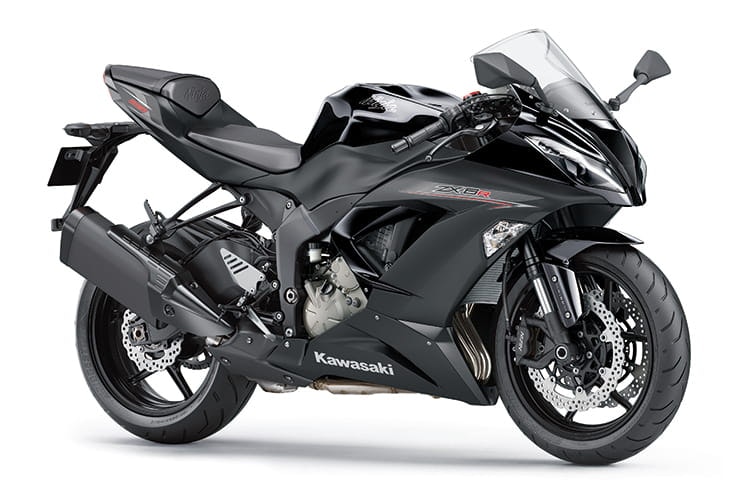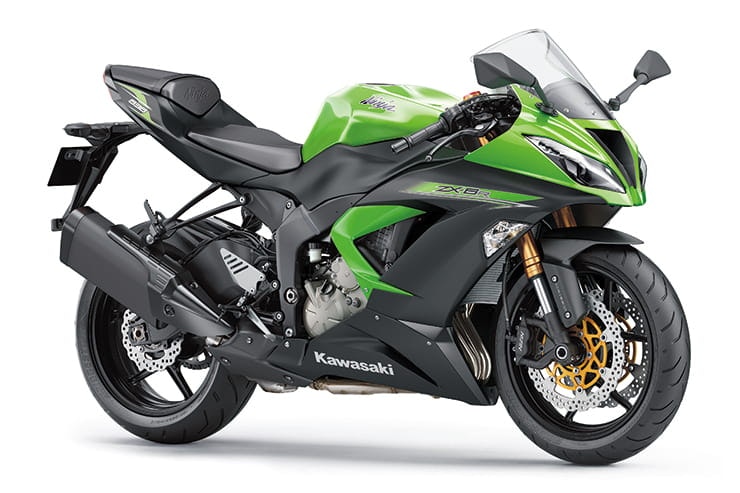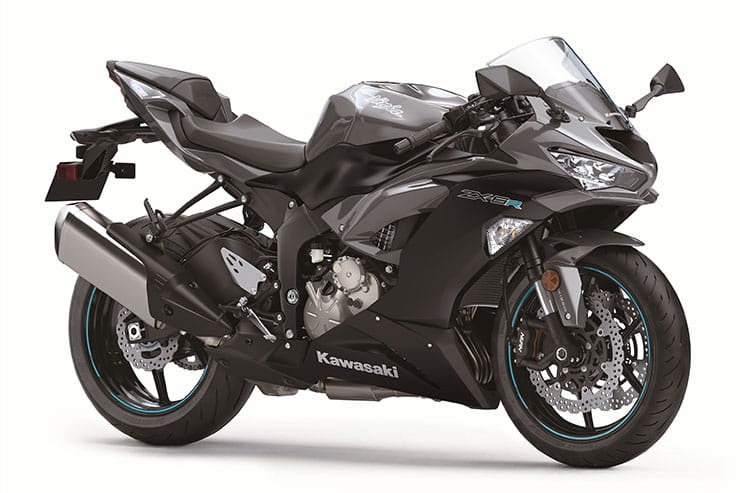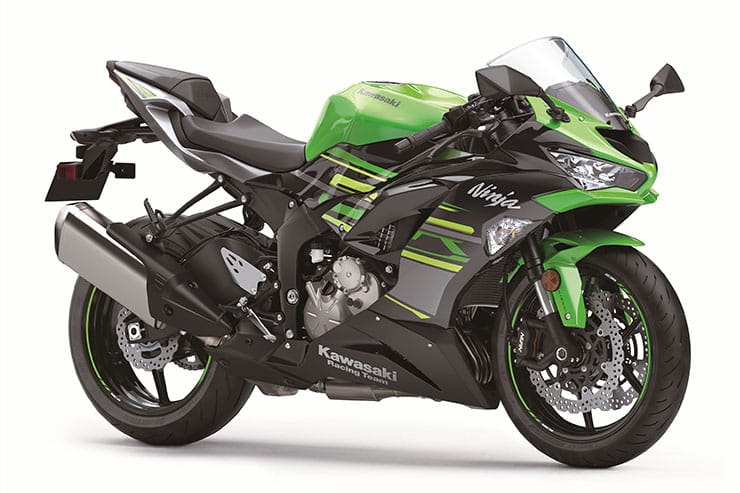Kawasaki Ninja ZX-6R (2013-2021): Review & Buying Guide
By Jon Urry
Massively experienced road tester
13.04.2023
Price: £6000-9000 | Power: 129bhp | Weight: 192kg | Overall BikeSocial Rating: 4/5
When Kawasaki launched what subsequently proved to be the final incarnation of their Ninja ZX-6R in 2013, they were riding high on the crest of a racing wave. Worldwide supersport sales may have been in decline but in the hands of Kenan Sofuoglu the green bike had just won the World Supersport title (it took two more titles in 2015 and 2016, also with the Turkish rider) and now Kawasaki looked to cash-in on his success when it came to their road bike. But how? That was the issue and so they did what they always do – they made the Ninja bigger in capacity to help it stand out from other 600s. And not only that, they added some electronic assists as well in the form of power modes, traction control and ABS. But all this came at a considerable financial cost and when the Ninja arrived, its price tag nearly touched £10,000 in top-spec form. Never a great seller, the Ninja may have been a great example of a supersport bike but a high price tag and the buying public’s general lack of interest in this class all conspired to see it a slow burner. Although sightly updated in 2019, this was the final foray for the Ninja ZX-6R and at the end of 2021 it was withdrawn from the firm’s model line-up. The last of a great dynasty, this generation of Ninja ZX-6R is undeniably the pinnacle of Kawasaki’s supersport bike’s development, and one with a gutsy motor for such a model, but realistically you need to be a real fan of supersport bikes to consider buying one over a used litre bike as the price tag remains very high.
Kawasaki Ninja ZX-6R (2013-2021) Price
When it was launched in 2013 the Ninja ZX-6R cost a huge £8999 in base trim or £9999 if you wanted one with KIBS, Kawasaki’s ABS system. Quite why ABS cost £1000 more is a bit of a mystery as Honda only charged £500 more to add it to a CBR600RR. In the used market you can pick up a 2013 Ninja for around £6000 nowadays but you do need to know not only its spec but also its model year as a lot of unsold 2012 bikes are registered on 2013 plates. First of all, check it is a 636cc model (the older one was 599cc, the new one has a 636 logo above its indicator) and then ask if it has KIBS, which the seller should know (it should be marked on the front mudguard). ABS-equipped bikes don’t generally sell for much more than non-ABS ones (roughly £300) but are worth having. Prices for the 2019 model (which has a quickshifter and ABS as standard, check it isn’t a late-registered 2018 model) start at £8000 and rise to £9000 for a very late 2021 machine. KRT colours cost £200 more when the Ninja was new but don’t command a premium in the used market. Interestingly, Kawasaki did make a 599cc R version, which was sold alongside the 636 to allow it to be homologated for race use, although very few are on the UK’s roads.
A high level of spec for a supersport bike
The last Ninja ZX-6R ever (so far...) built
Thrilling and superb-handling sportsbike
The price tag remains high and it’s uncomfortable
The engine is quite rev-hungry, despite its bigger capacity
The supersport class has lost its ‘cool factor’.
Engine and Performance
First of all, the Ninja is not a ‘big-bore’ 599cc motor as its bore is the same as before, it is a ‘longer-stroke’ engine as it has 2.6mm more of this to bring it up to 636cc. Ok, now we have that technicality out of the way, what else is new? To be honest, the 2013 engine is very similar to the older 599 motor however it does have cams with more lift and duration on the intake side, the conrods are shorter and stronger and, well, that’s about it. So, it is basically a tweaked older engine. Is that a bad thing? Not really, it has extra power just where you need it while still retaining the 599cc version’s banzai top end – making it the best of both worlds!
With a claimed 129bhp the Ninja only gains 3bhp over the older model, which is neither here nor there, what counts the most is the boost in mid-range torque. Thanks to its extra capacity the Ninja has a claimed peak torque of 52.4lb-ft where the old model was 49.2lb-ft, although this is a small increase in peak performance it manifests itself as big gains throughout the mid-range – which is just where you want it on a road bike.
Unlike the older Ninja model, you can open the 636 up in top gear and actually overtake without feeling like you need to shift down a few ratios to gain the required boost of acceleration. It’s not outstanding but it is noticeable and makes the bike (marginally...) less taxing to ride as there isn’t as much demand to continually keep it on the boil. That said, should you want to feed it revs, it responds in a typical Ninja fashion with lots of noise and also a remarkable turn of pace. Supersport bikes were never slow when you revved them and the Ninja is certainly a very rapid bike, despite its relatively small capacity size.
When buying used there is little to fear as the Ninja is so young, meaning not much is likely to have gone wrong. Interestingly, when it was updated in 2019 Kawasaki changed the final drive ratios to 15/43 from 16/43 to give it a bit more instant zap, which is worth testing out if you buy an older model. Aside from the usual check of its service history and ensuring that no warning lights are illuminated, all should be well when it comes to the motor. A few bikes may have been on a dyno and had emissions regulation-meeting equipment removed or blocked off, which isn’t a bad thing as long as the dyno house knows what they are doing.
Kawasaki Ninja ZX-6R (2013-2021) Handling & Suspension
Although the Ninja’s chassis is identical to before, it has slightly more aggressive geometry than the older bike and also a new generation of Showa forks. The Separate Function version of Showa’s Big Piston forks does exactly that, separate out the damping and preload functions to individual fork legs (preload on the left leg, damping on the right). The Showa shock also gains a longer and softer spring and new linkage system, although its actual body is unchanged. And stopping power is also enhanced through not only the option of KIBS but new monoblock Nissin radial brake calipers and bigger 310mm petal discs. How does it all work? As you would imagine, incredibly well...
On a sunny day, the Ninja will simply destroy a smooth twisty road and leave you grinning from ear to ear. Supersport bikes are immensely good fun to ride with unbelievably light handling and brakes that stop you in an instant. When you are in the mood, and the road is right, they turn every B-road into a race track and allow you to get away with lean angles and corner speeds you never thought possible while revving the motor to gain maximum drive. When the road is right...
Sadly the times when the road is right are few and far between in the UK and when the conditions aren’t perfect and you need to take it easy, the Ninja’s appeal quickly fades. Demanding and uncomfortable to ride, thrown in a few harsh bumps and your wrists will very quickly start to protest due to its firm suspension and low bars. Yes, modern litre bikes are just as focused, but their extra power means they can pull top gear with greater ease and they are generally a bit more roomy when it comes to their riding position. Sadly, it is times like these that you can see why supersport bikes have fallen by the wayside...
When it comes to buying used, you are generally looking out for neglect or track use with the Ninja. Inspect it well for any signs of crash damage, ensure the suspension is on factory settings (they will be in the manual, always return to standard when you buy a new bike) and check the linkages look nicely lubed. It is highly likely that the bike will have a good service history but if it is has a suspiciously low milage on its clocks, look at its MOT history on the government’s website. A bike that covers less than 500 miles a year is probably a track bike and best avoided – so look through its history. If it shows 5000 miles but covered 3000 of them five years ago, it has probably been used on track for the last few.
Comfort & Economy
The Ninja will generally record low 40s mpg figures with 41mpg about average, which gives it a tank range approaching 160 miles. Would you want to stay on it that long? Not really, the Ninja is a typical supersport bike with a small and quite cramped riding position, low bars and high pegs. The original screen is also fairly low and the seat pretty firm. So, overall, it doesn’t really add up to a bike that is much fun for anything other than short blasts!
Kawasaki Ninja ZX-6R (2013-2021) Equipment
The 2013 Ninja introduced variable fuel maps to the bike for the first time alongside Kawasaki Traction Control (KTRC) and Kawasaki Intelligent anti-lock Braking System (KIBS), which was a £1000 optional extra. In 2019 a further small update to the Ninja introduced a quickshifter (KQS), which only activates on upshifts, not down, LED lights and an updated dash and ABS became standard fitment.
KTRC is a three-stage system with two modes that ‘prioritise acceleration’ and a third that is for ‘smooth riding on low traction surfaces’ and the system can also be deactivated if required. Not angle-responsive, it uses wheel speed sensors to judge if the rear has lost traction. KIBS is also not angle-responsive and relies on the same wheel speed sensors while you get the option of Full or Low power modes. The dash has a fuel gauge, rev warning light and gear position indicator and an immobiliser is standard fitment.
When it comes to accessories, a lot of owners went for the KRT paint scheme, which cost £200 more than the stock options (black or grey) but was green, and also a single seat cover. Race exhaust end cans are popular as are tail tidies, taller screens and the occasional aftermarket brake and clutch lever. If the bike has uprated suspension you have to be a bit suspicious as that hints at track use and while a remapped ECU is helpful, it isn’t a huge selling point as the fuel-injection is pretty good as standard.
Kawasaki Ninja ZX-6R (2013-2021) Rivals
Supersport bikes used to be bought by younger riders as they were cheaper to insure, however that is no longer the case. The Ninja’s buyer is someone who is a fan of this class and isn’t interested in the extra power you get on a litre bike – and not necessarily a youngster!
Triumph Daytona 675R (2013-2018) | Approx Price: £6000-£9000
Power/Torque: 126bhp/55lb-ft | Weight: 199kg
Yamaha YZF-R6 (2008-2016) | Approx Price: £6000-£8500
Power/Torque: 133bhp/51lb-ft | Weight: 192kg
Honda CBR600RR (2007-2012) | Approx Price: £5000 - £7000
Power/Torque: 107bhp/44.6lb-ft | Weight: 194kg
Kawasaki Ninja ZX-6R (2013-2021) Verdict
If you ride a Ninja ZX-6R in isolation for a brief period, it is a superb machine. The handling is pin-point perfect, the 636cc engine has an impressive amount of drive for a 600 (ish...) and the bike itself has a good array of electronics that make it feel quite modern. But after a while you realise the riding position is cramped and the bike demands to be ridden aggressively everywhere, which you aren’t always in the mood to do and quickly starts to feel like hard work. If you don’t mind this attitude, the Ninja has more grunt than the Yamaha YZF-R6 and also the Honda CBR600RR and is far more reliable than the MV F3. The Triumph Daytona 675 is arguably a better road machine thanks to its triple engine’s grunt but while it has ABS, it lacks TC and is also pretty uncomfortable.
Overall, the Ninja is an acquired taste but it certainly has its fans and good luck to them because it is a real beauty of a supersport bike – if you like that kind of thing.
Kawasaki Ninja ZX-6R (2013-2021) – Technical Specification
Looking for motorcycle insurance? Get a quote for this motorbike with Bennetts bike insurance



